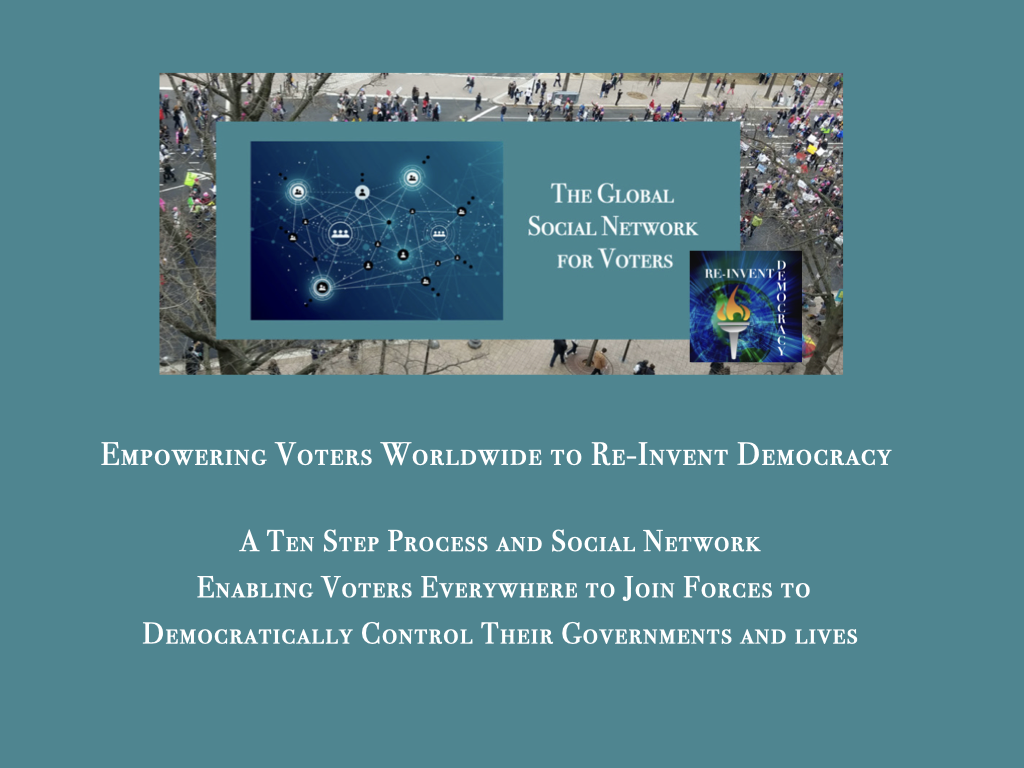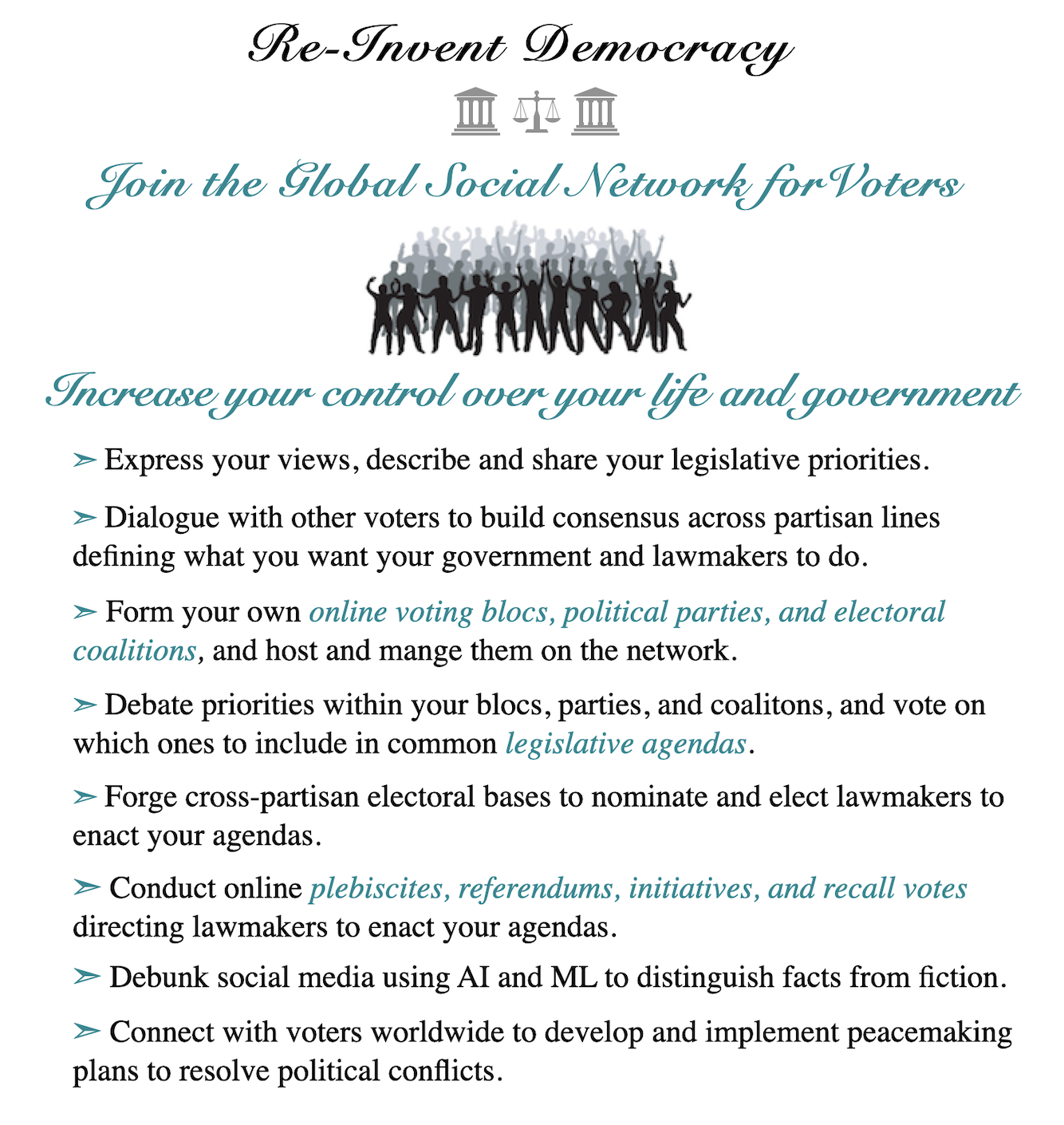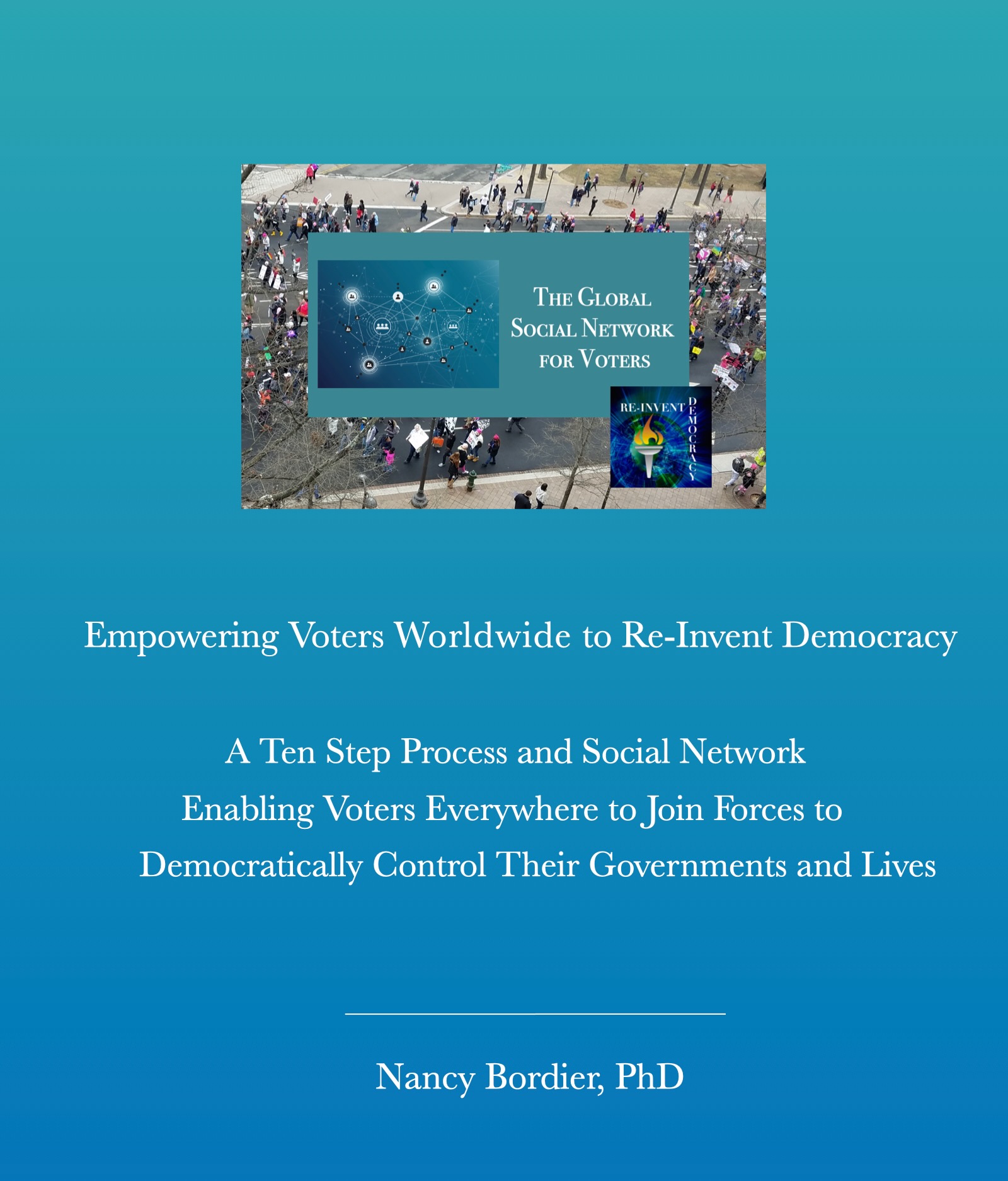
The Challenge
Global Democracy Decline
According to the International Institute for Democracy and Electoral Assistance based in Stockholm, Sweden,
"Half of democratic governments around the world are in decline, undermined by problems ranging from restrictions on freedom of expression to distrust in the legitimacy of elections."
"This decline comes as elected leaders face unprecedented challenges from Russia’s war in Ukraine, cost of living crises, a looming global recession and climate change."
"The number of backsliding countries—those with the most severe democractic erosion—is at its peak and includes the established democracy of the United States, which still faces problems of political polarization, institutional disfunction, and threats to civil liberties. Globally, the number of countries moving toward authoritarianism is more than double the number moving toward democracy."
"Global democracy’s decline includes undermining of credible elections results, restrictions on online freedoms and rights, youth disillusionment with political parties as well as out-of-touch leaders, intractable corruption, and the rise of extreme right parties that has polarized politics."
"The Global State of Democracy Indices (GSoD) show that authoritarian regimes have deepened their repression, with 2021 being the worst year on record. More than two-thirds of the world’s population now live in backsliding democracies or authoritarian and hybrid regimes."
"Other key findings:
- As of the end 2021, half of the 173 countries assessed by International IDEA are experiencing declines in at least one subattribute of democracy.
- In Europe, almost half of all democracies—a total of 17 countries-- have suffered erosion in the last five years. These declines affect 46 per cent of the high-performing democracies.
- Authoritarianism continues to deepen. Almost half of all authoritarian regimes have worsened.
- Democracy does not appear to be evolving in a way that reflects quickly changing needs and priorities. There is little improvement, even in democracies that are performing at mid-range or high levels.''
Key Causes of the Global Decline
1. Minority Rule
According to the Encyclopedia Brittanica,
“Democracy is a system of government in which laws, policies, leadership, and major undertakings of a state or other polity are directly or indirectly decided by the “people,” . . . generally understood since the mid-20th century to include all (or nearly all) adult citizens.”
In contrast, research indicates these vital decisions typically are not made directly or indirectly by "the people". Instead, in nations throughout the world the prevailing form of governance is more accurately described as "minority rule".
Harvard University Professors Levitsky and Ziblatt conducted research revealing the contours of minority rule in the US:
“Democracy is supposed to be a game of numbers: The party with the most votes wins. In our political system, however, the majority does not govern. Constitutional design and recent political geographic trends . . . have unintentionally conspired to produce what is effectively becoming minority rule.”
“No other established democracy has an Electoral College or makes regular use of the filibuster. And a political system that repeatedly allows a minority party to control the most powerful offices in the country cannot remain legitimate for long.”
In Tyranny of the Majority (2023),
"They draw on a wealth of examples—from 1930s France to present-day Thailand—to explain why and how political parties turn against democracy: When political leaders realize they can no longer win at the ballot box, they begin to attack the system from within, condoning violent extremists and using the law as a weapon. Unfortunately, our Constitution makes us uniquely vulnerable.
"It is a pernicious enabler of minority rule, allowing partisan minorities to consistently thwart and even rule over popular majorities. Most modern democracies—from Germany and Sweden to Argentina and New Zealand—have eliminated outdated institutions like elite upper chambers, indirect elections, and lifetime tenure for judges. The United States lags dangerously behind."
2. Political Parties
The large majority of factors contributing to the global democracy decline in the 21st century are instituted by undemocratic political parties. Their actions engender, legally and illegally, not only minority rule by lawmakers and legislative bodies, but chronic political conflicts and infighting between parties. These disruptive patterns lead to legislative stalemates for which they lack effective consensus building mechanisms.
By imposing constraints on the exercise of voting rights, they prevent voters from fully exercising their political sovereignty to determine who runs for office, who gets elected, and what laws are passed. Political parties and their organizational hierarchies typically monopolize these decisions, excluding voters from setting priorities and deciding which candidates can run on party ballot lines. This undemocratic monoplozation of electoral decisions compels voters to “choose” among party-nominated candidates who are already on official party ballot lines, and who run on platforms and legislative agendas over which voters exert little influence.
“No Choice” Elections and Loss of Public Trust. Various forms of voter disenfranchisement, particularly by gerrymandering in the U.S., vote suppression, electoral fraud, and vote rigging, contribute to widespread loss of public trust in political parties, elections, lawmakers and legislative bodies, facts corroborated in 2022 by the Pew Research Center in Washington, D.C.
One of the most striking repercussions is the widening gap between voters’ and constituents’ stated needs and priorities, contrasted with the priorities and laws enacted by elected representatives. US-based Pew Research indicates that for three decades, Americans have not believed lawmakers represent them, or care what they think. Its survey, "Trends in Political Values and Core Attitudes"" shows that
"Americans feel increasingly estranged from their government. Barely a third (34%) agree with the statement, ‘most elected officials care what people like me think,’ nearly matching the 20-year low of 33% recorded in 1994 and a 10-point drop since 2002."
More recent polls corroborate and extend these findings. Following the 2018 U.S. mid-term elections, half of registered voters expressed the view the newly elected Congress did not represent their views, including Democrats, Independents and Republicans. (See Most Americans Don’t Feel Well-Represented By Congress. (2018)
Recent research by university scholars confirm the perceptions, demands, and disillusionment of American voters, as reported in Opinion | Politicians Don’t Actually Care What Voters Want" (2018):
"Over the past two years, we conducted a study to find out [what voters want]. We provided state legislators in the United States with access to highly detailed public opinion survey data — more detailed than almost all available opinion polls — about their constituents’ attitudes on gun control, infrastructure spending, abortion and many other policy issues. Afterward, we gauged the willingness of representatives to look at the data as well as how the data affected their perceptions of their constituents’ opinions."
"What we found should alarm all Americans. An overwhelming majority of legislators were uninterested in learning about their constituents’ views. Perhaps more worrisome, however, was that when the legislators who did view the data were surveyed afterward, they were no better at understanding what their constituents wanted than legislators who had not looked at the data. For most politicians, voters’ views seemed almost irrelevant."
3. Populism and Anti-Government Attacks
Lawmakers and political parties controlling governments elected through undemocratic "No Choice" elections are distrusted by people they should serve, but do not enable to obtain basic life necessities and financial security. OECD" (2021)
When elections and electoral outcomes are not determined by voters, they choose alternative means to press their demands, including street-level demonstrations, protests, and violent confrontations.
400 significant anti-government protests have occurred in 132 countries worldwide since 2017, according to the Carnegie Endowment for International Peace" (2023).
Dissatisfied individuals and groups angered by chronic political conflicts sparked by lawmakers and parties oppose their actions in street-level demonstrations, protests, and violent confrontations. They disrupt socio-economic activities and governmental processes, including elections.
4. Loss of Control
By preventing majority rule, and fueling chronic political conflicts and legislative stalemates, political parties often prevent governments from making decisions that enable government agencies to function on a day-to-day basis, and resolve crises and emergencies. They render ordinary people at the grassroots virtually powerless to invoke government action they need to obtain the basic necessities of life, e.g. passing laws that ensure living wages and affordable housing and healthcare, and providing disaster recovery assistance in the face of catastrophic climate disruption.
What is needed to correct these "democratic deficits" diminishing the capabilities of governments and lawmakers to serve the public good is a global power shift from undemocratic political parties, lawmakers, and legislative bodies to the people they must serve at the grassroots.
This global power shift can be implemented using the 10 Step Process described below that enables voters around the world to wrest control of elections and governing processes from undemocratic political parties and undemocratically elected, minority rule governments, so they can increase their control over their lives without external interference. These steps incorporate consensus building mechanisms that enable virtually unlimited numbers of people to connect online via an autonomous social networking platform, set common legislative agendas, and build their own voting blocs, political parties, and electoral coalitions to elect lawmakers to enact their agendas.
In anticipation of the description, here's a short synopsis of the types of empowerment the social network's tools provide voters to increase their control over their own lives, their elections, and their governments (voters include individuals intending to vote, even if they have yet to be officially registered in an election district in which they are eligible to vote).
a. Network tools enable voters to extend their spheres of influence beyond the boundaries of an election district in which they may be eligible to vote, by enabling them to join forces with voters in other election districts, within and beyond a single nation-state.
b. Voters can use network communication tools at any time, day and night, to connect online with other voters using the network for a broad array of purposes.
c. They can individually define, express and share their needs, priorities, and legislative agendas with other voters using the network whose identifies have been verified.
d. The needs, priorities, and agendas that voters define do not have to conform to those of any political party, and can be updated, stored, retrieved, and shared at any time.
e. For the first time in history, voters have an autonomous web-based platform where they can individually and collectively define priorities and legislative agendas that affect regions and election districts anywhere in their home country, and in nations and regions around the world.
f. To call attention to their priorities and agendas on the part of individuals and groups outside the network, voters can use the network’s online voting utility to calculate how many voters support specific priorities and agendas, regions and election districts in which these voters reside (although voters can decide whether or not to provide this information), and publicize these numbers and locations through as many channels as they see fit.
g. Voters can also share their needs, priorities, and legislative mandates with lawmakers anywhere at any time, and alert unresponsive lawmakers to the numbers of dissatisfied voters in their election districts who indicate they are learning towards voting to defeat them in future elections.
h. The network’s AI and ML-based agenda-setting, consensus-building, and political organizing tools empower voters to create their own online political parties, and work within and between them to build consensus across partisan lines in support of specific agendas, as well as reach out across partisan lines to forge electoral bases large enough to win elections to defeat incumbent lawmakers and elect lawmakers of their choice to replace them.
i. Voters can bypass AI-generated information containing falsehoods and misrepresentations, and actively participate in elections and influence legislative decision-making, by using the network’s person-to-person and teleconferencing tools to engage in real-time, face-to-face interactions with other network users.
To summarize, the 10 Step Process enables voters worldwide to re-invent democracy and thereby increase their control over their lives and their governments.

Notably, the U.S. political system is used above and below as a case in point of key causes characterizing global democracy decline due to its recent ranking internationally as a "flawed democracy" -- a sharp contrast to its formerly heralded model democracy.
Outline of the 10 Step Process
Step 1. Voters use the Global Social Network for Voters to create a decentralized civic infrastructure of democracy by engaging in continuous grassroots deliberations, debates, and online voting.
Step 2. Voters use the crowdsourcing tools accessible on the Global Social Network for Voters to connect and unite online to gain control of elections and legislation.
Step 3. Voters define and share their legislative priorities, collaborate to build consensus across partisan lines, and collectively set common legislative agendas.
Step 4. Voters join forces online to build their own online voting blocs, political parties, and electoral coalitions.
Step 5. Voters’ blocs, parties, and coalitions nominate electoral candidates, place them on official ballot lines, and elect them to enact voters' legislative agendas.
Step 6. Voters fact check and debunk social media disinformation using the network's Artificial Intelligence (AI) and Machine Learning (ML) tools.
Step 7. Voters use Global Social Network for Voters tools to conduct petition drives, referenda, initiatives, and recall votes; publicize their results, and mandate lawmakers to enact voters' legislative priorities.
Step 8.Voters mandate lawmakers they elect to reform election laws and legislative processes to ensure Majority Rule throughout all branches of government, while protecting universally recognized Minority Rights.
Step 9. Voters use network tools to raise funds online to finance and conduct campaigns to elect their candidates.
Step 10. Voters create a new "International Order" by building multi-national online voting blocs, political parties, and electoral coalitions; devising and enacting common peace-keeping plans; and voting online to collectively deploy multi-national peacekeepers to resolve conflicts without the use of force.
A detailed description of the 10 Step Process is provided in this e-book:

Copyright © 2024 VotersUnited.Global, PBC
All Rights Reserved